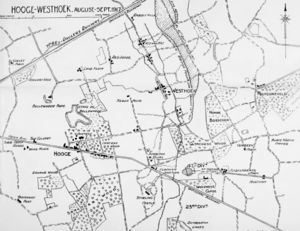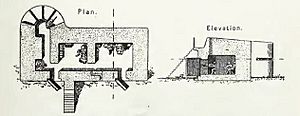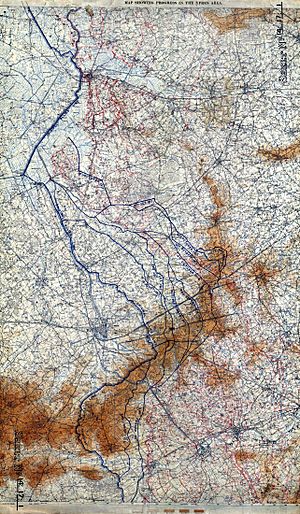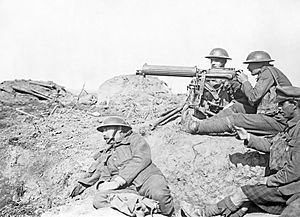Capture of Westhoek facts for kids
Quick facts for kids Capture of Westhoek |
|||||||
|---|---|---|---|---|---|---|---|
| Part of the Third Battle of Ypres, in the First World War | |||||||
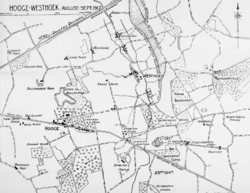 Gheluvelt Plateau: Inverness Copse, Westhoek and Glencorse Wood |
|||||||
|
|||||||
| Belligerents | |||||||
| Commanders and leaders | |||||||
| Sir Douglas Haig | Crown Prince Rupprecht | ||||||
| Strength | |||||||
| 2 divisions | 6 regiments | ||||||
| Casualties and losses | |||||||
| 25th Division: 1,291 18th (Eastern) Division: 1,526 (31 July – 10 August) |
4th Army: 16,000 (1–10 August) | ||||||
| German casualties were counted in ten-day periods. | |||||||
The Capture of Westhoek happened on 10 August 1917. It was a battle on the Gheluvelt Plateau near Ypres in Belgium. This fight was part of the larger Third Battle of Ypres (which lasted from 31 July to 10 November 1917) during the First World War.
The British Fifth Army tried to attack the Gheluvelt Plateau earlier, on 31 July. This was during the Battle of Pilckem Ridge. However, the German 4th Army had made their positions very strong in the Ypres Salient. They had been building defenses since the Second Battle of Ypres in 1915.
On 31 July, the British reached some of their goals. But they lost some ground to German counter-attacks. A new British attack was planned for 2 August. However, it had to be delayed. Heavy rain fell from 31 July until 5 August. This turned the battlefield into a huge muddy mess.
The ground was completely ruined by artillery shells. It became a swamp of mud, flooded shell holes, broken trees, and tangled barbed wire. After several delays, the attack was finally set for 10 August. British cannons fired a lot of shells to prepare for a bigger attack later. But the German cannons focused their fire on the Gheluvelt Plateau. Bad weather made it hard for British planes to see. This meant their counter-battery fire (shooting at enemy cannons) was not very effective.
New British divisions arrived by 4 August. But the soldiers on the front line had to be replaced every two days. This made all the infantry very tired by 10 August. The German soldiers were also exhausted.
The British attack on the right side started well. Some troops quickly reached their goals. On the left, soldiers from the 25th Division moved fast. They reached their targets by 5:30 a.m. The Germans in Westhoek were quickly pushed back. But on the right, German snipers and planes caused more and more British casualties. German cannons started a heavy barrage around 6:00 a.m. This cut off the British soldiers from supplies. The British infantry at the front were trapped in the open. German troops counter-attacked. By nightfall, the Germans had taken back Inverness Copse and most of Glencorse Wood.
The 25th Division managed to hold onto Westhoek. But they lost 158 men killed, 1,033 wounded, and over 100 missing. The 18th (Eastern) Division was defeated at Inverness Copse and Glencorse Wood. This allowed German snipers and machine-gunners to shoot at the 25th Division's right side. German counter-attacks continued all night. But the British used signal rockets, lamps, pigeons, and runners. This helped their cannons accurately hit German troops as they gathered.
Contents
Understanding the Battleground
The Ypres Area
Ypres is a city in Belgium. It is surrounded by low hills. To the southwest is Kemmel Hill. To the east are hills with places like Wytschaete and Hill 60. These hills are not very high. Wytschaete is about 150 feet above the flat land. At Hooge, on the Ypres–Menin road, it's about 100 feet high.
These small hills were very important in the war. Being on higher ground meant soldiers could see far. They could also shoot at enemies from above. This made it easier to hit targets with cannons. It also meant they could hide their own movements. They could move cannons, supplies, and soldiers without being seen.
In 1914, there were woods on these hills. Places like Polygon Wood and Sanctuary Wood provided good cover. But by 1917, years of shelling had destroyed them. The woods were just broken tree stumps and tangled wire. The open fields between the woods had no cover. Most roads were unpaved and muddy.
Preparing for Battle
German Defenses
The German 4th Army was in charge of defending this area. They had a strong system of defenses. Instead of deep dugouts, they built many small concrete bunkers called pillboxes. These were built above ground because the land was flat and wet. They were hidden with mud and grass. Many stone farmhouses were also turned into strongholds. These shelters could hold many soldiers and were very tough.
The Germans had several lines of defense. The front line had breastworks (low walls). Behind that was a forward battle zone. Further back were more strong positions. The idea was to slow down any attack. They wanted to wear out the enemy before they reached the main German lines. They also had special "counter-attack" divisions ready. These divisions would quickly move forward to push back any enemy who broke through.
German soldiers also got new machine guns. This gave them more firepower. They formed small groups of soldiers called Stoßtruppen (storm troops). These groups were trained to fight aggressively and counter-attack.
Weather and Delays
| Date | Rain mm |
°F | |
|---|---|---|---|
| 31 | 21.7 | 69 | dull |
| 1 | 21.5 | 59 | — |
| 2 | 5.3 | 59 | — |
| 3 | 9.9 | 59 | — |
| 4 | 4.9 | 66 | dull |
| 5 | 0.0 | 73 | clear |
| 6 | 0.1 | 71 | cloud |
| 7 | 0.0 | 69 | cloud |
| 8 | 10.2 | 71 | cloud |
| 9 | 0.2 | 68 | clear |
| 10 | 1.5 | 69 | clear |
After the first attack on 31 July, the British wanted to attack again. But heavy rain started that day and continued for three days. This turned the ground into a huge swamp. Streams became bogs, and roads were covered in deep mud. Moving supplies and soldiers was very difficult and dangerous. Many soldiers got stuck or drowned in the mud.
The bad weather also made it hard for British planes to fly. This meant they couldn't see where German cannons were. So, British artillery often shot at empty positions. This made it difficult for them to destroy German cannons.
Because of the mud and rain, the British delayed their attack several times. New divisions were brought in, but the terrible conditions quickly tired them out. The Germans were also very tired from fighting and the bad weather. On the night of 9/10 August, both sides fired a lot of artillery. German soldiers captured some British patrols. These prisoners told the Germans about the upcoming attack.
British Attack Plan
The British plan was to attack at 4:35 a.m. on 10 August. Their infantry would advance behind a moving wall of artillery fire called a creeping barrage. They aimed to capture key German positions like Inverness Copse and Glencorse Wood. The artillery barrage moved quickly. This gave the attacking divisions a short time to reach their goals.
Before the attack, the British heavily shelled Inverness Copse and Glencorse Wood. They fired thousands of shells on 8 and 9 August. The 25th Division planned to attack Westhoek and the surrounding ridge. Some parts of their objective were already taken by aggressive patrols before the main attack.
The Battle of Westhoek
British Attacks on the Plateau
On the right side of the attack, British soldiers from the 18th (Eastern) Division faced strong German machine-gun fire. Some troops managed to get into Glencorse Wood. They even captured 40 prisoners from German bunkers. Other soldiers reached Fitzclarence Farm. There were many small fights around the German pillboxes. These bunkers were like islands in a sea of mud. Both sides fought hard to capture and recapture them.
The British soldiers could not connect with other units. This left a big gap between them. German troops counter-attacked from Inverness Copse. They used smoke to hide their movements. This forced the British back from their most advanced positions.
Another British battalion, the 7th Bedford, had to cross a muddy area with broken tanks. They aimed to capture ten pillboxes and fight through Glencorse Wood. They advanced unseen at first. But they were stopped by uncut wire at the German front trench. They fought through the wood with grenades and bayonets. They reached their objective, but they were isolated. Other British units to their north and south had not reached their goals.
The ground was too muddy to dig proper trenches. The 7th Bedford soldiers defended their positions in the wood for about four hours. But by noon, they were forced back to the western edge of the wood. In the evening, German infantry moved into Polygon Wood. Around 7:00 p.m., a very heavy German bombardment hit Glencorse Wood. German reserve troops advanced behind a smokescreen. They attacked from Inverness Copse. The British were forced back to their starting line on the right.
The Fight for Westhoek Ridge
On the left side, four battalions of the 74th Brigade (25th Division) attacked. They moved quickly and avoided the German counter-barrage. They overran German outposts by 5:30 a.m., capturing several pillboxes. In Westhoek village, the German defenders were surprised. A deep, muddy swamp in the Hanebeek Valley protected the British from counter-attacks.
Further north, a British battalion faced a pillbox that caused a delay. They lost many soldiers to sniper fire. German planes flew low and shot at British troops moving in the open. Despite this, the British captured their objectives, machine guns, and prisoners. German artillery fired all day. But the British kept contact with their own cannons. Their artillery quickly fired back, breaking up German groups preparing to counter-attack.
As Germans retook Glencorse Wood on the British right, German snipers and machine-gunners made it hard for the British to dig in. It was impossible to create a continuous front line trench. British reserve battalions were sent forward. The Germans tried several counter-attacks into the night. Most were stopped by British artillery. One German attack was defeated by British rifle and machine-gun fire. Two Vickers machine guns fired 10,000 rounds, hitting German counter-attacks.
After the Battle
Counting the Cost
The battle was very costly for both sides. The British 25th Division had 1,291 casualties. This included 158 killed, 1,033 wounded, and 100 missing. One battalion alone lost 414 men. The 74th Brigade lost 1,318 men in less than a week. The 18th (Eastern) Division had 1,526 casualties from 31 July to 10 August. They took 59 German prisoners.
A British general reported that he saw more German dead in the Hanebeek Valley than on any previous battlefield. The German 4th Army lost 16,000 men between 1 and 10 August. The wet and cold weather also caused a lot of sickness among the soldiers.
What Happened Next
After the battle, the British tried to strengthen their new front line. They also planned to recapture Glencorse Wood. But bad weather and ground conditions caused delays. The attack was postponed and then canceled.
The British attacked the plateau again on 16 August. This was part of the Battle of Langemarck. They also tried to take Inverness Copse on 22 August. But the Germans launched a counter-attack on 24 August and recaptured the Copse. Another British attack on Inverness Copse on 27 August failed. Their tanks got stuck in the mud. More rain caused another attack to be canceled on 31 August.
In early September, another British army took over the front line on the Gheluvelt Plateau. They were given three weeks to prepare for the next attack. From June to August, the British artillery fired over 2.7 million shells in this area.
Images for kids


